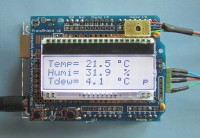Measuring dew point, temperature and humidity with ENS210 and Arduino Uno

The difference between the current temperature and the dew point provides a reliable indication of the risk of mould growth on walls or furnishings
The dew point indicates not only the risk of mould growth but also the risk of corrosion of steel tools. You can influence the dew point by ventilating and heating. To do this, however, you must determine the dew point. That is exactly what this smart device is doing.
First and foremost, however, this device is a very precise measuring instrument. The high measuring accuracy of temperature and humidity makes it very useful. The here used sensor, the ENS210 from "ams", is probably the most precise, pre-calibrated sensor on the market. The temperature is measured with an accuracy of +-0.2°C in the range of 0°C to 70°C without any calibration. Therefore the ENS210 is suitable as a reference for the calibration of temperature and humidity sensors.
The dew point is calculated from the measurement results for T and H. The approximation formula according to "Magnus" is used for this. Additionally, the difference between the dew point and the current temperature is determined, which gives a very good indication of whether mould growth or corrosion is to be feared.
All measurement results are shown on a display and are also sent to the serial monitor or the serial plotter of the Arduino "IDE". The serial output format is selectable for either the monitor or the plotter by means of a button.
An extremely attractive, 3-line LCD display with white backlight, from "Electronic Assembly", is used. With only a few additional functions many methods of the standard library "LiquidCrystal" can further be used. The library itself does not need to be altered.
Of course, it is also possible to use elektor LCD shield.
The ENS210 provides an IIC interface so that no additional hardware is required. The program contains all routines for controlling the ENS210.
Due to the use of an Arduino UNO, the hardware required for this project is very simple. Only soldering the very small sensor chip with its package of only 2mm*2mm is a certain challenge. However, a method is shown with which it is possible to solder the chip to a piece of hole pattern board without
any problems. The few electrical connections to the LCD display can easily be made on a proto shield. A socket is provided on this shield to connect the sensor via a cable.
Project Highlights
Further Prospects
If there is sufficient interest, a PCB can be designed. On the PCB some push buttons could be provided to control a data logger function. This function would store the measured data non volatile in the EEPROM.
First and foremost, however, this device is a very precise measuring instrument. The high measuring accuracy of temperature and humidity makes it very useful. The here used sensor, the ENS210 from "ams", is probably the most precise, pre-calibrated sensor on the market. The temperature is measured with an accuracy of +-0.2°C in the range of 0°C to 70°C without any calibration. Therefore the ENS210 is suitable as a reference for the calibration of temperature and humidity sensors.
The dew point is calculated from the measurement results for T and H. The approximation formula according to "Magnus" is used for this. Additionally, the difference between the dew point and the current temperature is determined, which gives a very good indication of whether mould growth or corrosion is to be feared.
All measurement results are shown on a display and are also sent to the serial monitor or the serial plotter of the Arduino "IDE". The serial output format is selectable for either the monitor or the plotter by means of a button.
An extremely attractive, 3-line LCD display with white backlight, from "Electronic Assembly", is used. With only a few additional functions many methods of the standard library "LiquidCrystal" can further be used. The library itself does not need to be altered.
Of course, it is also possible to use elektor LCD shield.
The ENS210 provides an IIC interface so that no additional hardware is required. The program contains all routines for controlling the ENS210.
Due to the use of an Arduino UNO, the hardware required for this project is very simple. Only soldering the very small sensor chip with its package of only 2mm*2mm is a certain challenge. However, a method is shown with which it is possible to solder the chip to a piece of hole pattern board without
any problems. The few electrical connections to the LCD display can easily be made on a proto shield. A socket is provided on this shield to connect the sensor via a cable.
Project Highlights
- high accuracy temperature and humidity sensor
- very small sensor with low heat capacity
- calculation of dewpoint
- very attractive display with three lines and white backlight
- standard 4 bit data bus interface to control the display
- possible supplying by 4 AA cells due to the integrated voltage booster at LCD controller
- enabling/disabling of booster by software
- adjustment of LCD contrast depending on supply voltage by software
- correct measuring of 5 Volt supply by measuring the ratio of bandgap to AVCC
- simple and clearly structured program, therefore easily adaptable to own tasks
Further Prospects
If there is sufficient interest, a PCB can be designed. On the PCB some push buttons could be provided to control a data logger function. This function would store the measured data non volatile in the EEPROM.



Mises à jour de l'auteur